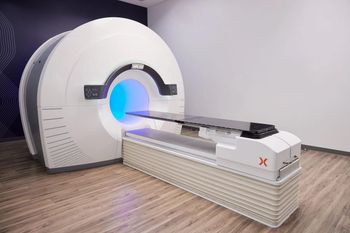
Gadolinium-Based Contrast Agent Does Not Change Diagnostic Accuracy of Breast Diffusion-Tensor Imaging
Limitations in contrast enhancement standardization indicate unenhanced diffusion measurement should be preferred.
Using a gadolinium-based contrast agent (GBCA) with diffusion-tensor imaging (DTI) does not change the accuracy of breast cancer diagnosis, according to a new study.
In an article published in the
“Diagnostic accuracy using DTI was equivalent before and after GBCA administration, despite a change in the values of the DTI parameters,” wrote the team, led by Anabel M. Scaranelo, M.D., Ph.D., assistant professor of radiology. “However, the limitations in standardization of contrast enhancement implies that unenhanced diffusion measurements should be preferred.”
To make this determination, the team conducted a pilot study with 26 women, ranging from ages 37 to 69, who had BI-RADS scores of 0, 4, 5, and 6. The participants were scheduled for diagnostic breast 3T MRI and were scanned twice using the same DTI sequence both before and immediately after the breast dynamic contrast-enhanced MRI.
The team used dedicated DTI software to conduct quantitative image analysis to produce parametric DTI maps of each directional diffusion co-efficient (DDC), mean diffusivity, and maximal anisotropy of the lesions and normal tissue. They, then, used statistical tests to evaluate the color maps and compare the lesion DTI parameters both before and after GBCA administration.
According to the analysis conducted by Scaranelo’s team, 58 percent of the women were diagnosed with cancer – 13 women had infiltrating ductal carcinoma and two had ductal carcinoma in situ. The remaining 42 percent had benign or normal results. All of the cancers could be visually identified in the DDCλ1 maps both before and after GBCA use. The mean cancer size of 15.3 mm prior to use, and it was not statistically significantly different afterwards, the team said.
However, after GBCA use, Scaranelo said, the cancers did demonstrate statistically significantly lower DDCs, mean diffusivity, and b0 intentsity. They also exhibited no change in maximal anisotropy when evaluated against pre-GBCA administration. In fact, the mean AUC values both before and after GBCA administration were not statistically significantly different for all parameters other than λ3.
Based on these findings, the team determined there was a statistically significant reduction in the DDCs of breast cancer after dynamic contrast enhancement. As a result, they said, the enhancement leads “to equivalent or increased conspicuity of the cancer lesions in the visual assessment by the radiologist.”
Given that the accuracy of breast cancer detection was not significantly different for unenhanced or contrast-enhanced DTI datasets – and because DTI parameters are intrinsic tissue characteristics – Scaranelo said DTI use prior to dynamic contrast enhancement should be fully standardized.
“The contrast-enhanced DTI parameters are less amenable to standardization because their values depend on the type and dose of contrast agent and on variations in the contrast agent dynamics among the various types of breast cancers,” she explained, noting that the lack of contrast-enhanced DTI standardization supports the preference for unenhanced diffusion measurements.
Newsletter
Stay at the forefront of radiology with the Diagnostic Imaging newsletter, delivering the latest news, clinical insights, and imaging advancements for today’s radiologists.




























